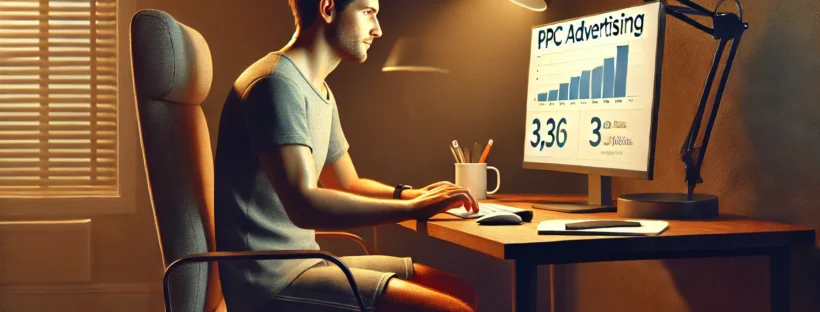Struggling to Maximise ROI? Here’s Why PPC Might Be Your Solution
Many businesses pour thousands into digital advertising but struggle to see a significant return on investment (ROI). Ever wondered why?
The problem often lies in poor audience targeting, wasted ad spend, and ineffective bidding strategies. Pay-per-click (PPC) advertising can be an incredibly powerful tool for driving leads and revenue—but only when executed correctly.
From setting the right budget to crafting compelling ad copy, businesses face several challenges in making PPC profitable. Ad fatigue, irrelevant clicks, and inefficient keyword research often drain resources without delivering real results. But what if you could transform your PPC campaigns into a high-ROI machine?
In this guide, we’ll break down essential strategies for increasing PPC ROI, from advanced audience targeting to AI-powered bidding tactics. If you’re looking to optimise your ad spend and boost conversions, read on!
Understanding PPC ROI and Its Key Metrics
PPC advertising is all about paying for visibility, but are you getting the returns you expect? ROI in search engine marketing measures the profitability of your ad campaigns. If your ROI is low, you’re essentially spending more than you earn, making the entire effort unsustainable.

Key PPC Metrics to Track for Maximum ROI
- Click-Through Rate (CTR) – Measures how many users click your ad compared to impressions. A low CTR indicates weak ad copy or poor audience targeting.
- Conversion Rate (CVR) – The percentage of users who take the desired action after clicking your ad (e.g., purchasing, signing up, or contacting you). A poor CVR may mean your landing pages aren’t compelling enough.
- Cost Per Click (CPC) & Cost Per Acquisition (CPA) – CPC tells you how much you’re paying per click, while CPA reveals how much you spend to acquire a customer. Both metrics directly impact profitability.
- Quality Score – Google ranks your ad’s relevance based on factors like selected keywords, landing page experience, and CTR. A higher Quality Score leads to lower CPC and better ad placements.
How to Calculate PPC ROI
To measure ROI effectively:
PPC ROI = (Revenue from PPC – Cost of PPC) ÷ Cost of PPC × 100%
Use this ROI calculator to analyse your PPC performance and identify optimisation opportunities.
Advanced Audience Targeting for Higher ROI
Generic, broad targeting often leads to wasted ad spend. The key to increasing ROI is intent-based audience targeting—showing ads to users who are more likely to convert.
Audience Segmentation Strategies
1. Demographic Targeting
Understanding your ideal audience based on age, gender, location, income, and device preference ensures that your PPC ads reach those most likely to engage. For instance, luxury brands may prioritise high-income users, while mobile-first businesses should focus on smartphone users.
2. Behavioural Targeting
Rather than relying solely on demographics, behavioural targeting uses browsing history, past purchases, and search intent to refine ad delivery. Someone searching for “best PPC strategies” is far more likely to convert than a general digital marketing enthusiast.
3. Retargeting & Lookalike Audiences
Retargeting helps reconnect with users who previously visited your web page but didn’t convert. Lookalike audiences allow you to target new users who share characteristics with your existing customers—expanding reach without losing relevance.
Data-Driven Tools for Effective Targeting
- Google Ads Audience Insights – Identifies high-value customer segments based on online behaviour.
- Facebook Pixel – Tracks user activity on your websites for more precise social media advertising on Facebook & Instagram.
- Customer Match Lists – Uses email-based targeting to serve search ads and display advertising to existing customers or similar prospects.
Crafting High-Performing Ad Copy That Converts
No matter how targeted your audience is, ineffective ad copy will result in poor ROI. The right words can make the difference between an ignored ad and a high-converting one.
Psychological Triggers in Ad Copywriting
- Urgency – “Limited Time Offer – Save 30% Today!”
- Exclusivity – “Only Available to Our VIP Customers”
- Trust – “5,000+ Businesses Trust Us – See Why!”
Winning Headline Formulas
- Problem-Solution Approach: “Struggling with High CPC? Lower It by 30% Today!”
- Benefit-Driven Approach: “Boost Your PPC ROI – Proven Strategies Inside!”
Call-to-Action (CTA) Strategies

A strong CTA guides users toward taking immediate action.
- Action words: “Get a Free Quote,” “Start Your Free Trial,” “Sign Up Today”
- CTA placement: Ensure visibility within the ad, on the landing page, and in retargeting ads
- A/B Testing: Experiment with different CTAs, colors, and placements to identify what drives the highest click-through rate (CTR)
Avoiding Ad Fatigue
Repetitive ads lose effectiveness over time. Regularly refreshing headlines, descriptions, and visuals keeps engagement high. Dynamic ads that adapt based on user behaviour enhance personalisation and conversion rates.
Landing Page Optimisation: The Make-or-Break Factor
A well-optimised landing page is the difference between a high-converting PPC campaign and wasted ad spend. Even if your ad copy is compelling, a poorly designed landing page will drive potential users away.
Why Landing Page Experience Matters
Search engines like Google consider landing page experience when ranking ads. A slow, cluttered, or irrelevant web page lowers Quality Score, increases bounce rate, and reduces conversions.
Essential Elements of a High-Converting Landing Page
- Fast Load Speed – Pages that take more than a few seconds to load lose nearly 40% of visitors. Use tools like Google PageSpeed Insights to check your speed.
- Clear & Action-Driven CTA – Whether it’s “Get a Free Quote” or “Start Your Trial,” make the CTA visible and compelling to drive the desired action.
- Social Proof – Customer testimonials, case studies, and trust badges build credibility and encourage conversions.
- Heatmaps & Session Recordings – Tools like Hotjar and Microsoft Clarity analyse user behaviour, helping refine page elements for higher conversions.
AI & Automation: Smart Bidding Strategies for Maximum ROI
Artificial Intelligence (AI) is transforming PPC advertising, making it smarter, faster, and more cost-effective. Smart Bidding strategies use AI to adjust bids dynamically, maximising ROI without manual intervention.
Top AI Bidding Strategies
- Target ROAS (Return on Ad Spend) – Focuses on maximising revenue rather than just conversions, ideal for eCommerce businesses.
- Maximise Conversions – Uses AI to bid for the highest possible conversion rates within your ad spend.
- Enhanced CPC (ECPC) – Automatically adjusts manual bids to drive more conversions at lower costs.
AI-Powered Tools for PPC Optimisation
- Google’s Performance Max Campaigns – Automates ad placements across Google Search, display ads, YouTube, and more.
- Third-Party AI Platforms – Tools like Adzooma and WordStream help refine bidding strategies for better efficiency.
Case Study: 40% Higher ROI with Smart Bidding
A UK-based retail brand saw a 40% increase in ROI by switching from manual bidding to Google’s Maximise Conversions strategy. By letting AI adjust bids in real-time, they achieved higher conversions while lowering their CPC.
Budgeting and Bid Management: Avoiding Wasted Spend
Effective PPC budgeting ensures maximum conversions without overspending. Many businesses either allocate too little, limiting their reach, or too much, leading to wasted ad spend. A data-driven approach is essential for maintaining profitability.
Allocating Budget Strategically
Budget distribution should be based on:
- High-performing campaigns – Shift more funds towards ads generating the best ROI.
- Audience intent – Prioritise ad campaigns targeting users ready to convert.
- Seasonality & trends – Adjust spending during peak sales periods.
Bid Adjustment Tactics for Optimised Performance
- Device-Specific Bidding – Mobile users convert differently than desktop users. Adjust bids accordingly.
- Location-Based Bid Modifications – Increase bids in areas where conversion rates are higher.
- Time-of-Day & Seasonal Adjustments – Analyse performance trends to increase bids during high-converting hours and reduce spending during low-demand periods.
Preventing Budget Drain: Negative Keywords
Negative keywords prevent irrelevant clicks, saving money and improving ROI. For example, a premium digital marketing agency might exclude searches like “free PPC tools” or “cheap ads” to filter out low-intent users.
Using Google Keyword Planner helps identify irrelevant terms that are wasting budget.
Multi-Channel PPC Advertising: Beyond Google Ads
Relying solely on Google Ads limits your reach. Expanding to other PPC advertising platforms can lower CPC, target diverse audiences, and improve ROI.
Best-Performing Alternative PPC Platforms
- Microsoft (Bing) Ads – Lower competition than Google, leading to cheaper CPC and higher ROI for certain industries.
- Facebook & Instagram Ads – Ideal for social media advertising, with advanced audience segmentation options.
- LinkedIn Ads – Best for B2B marketing, helping brands connect with high-intent decision-makers.
Cross-Platform Retargeting for Higher Conversions
Multi-channel PPC ensures brand visibility across platforms, reinforcing trust and recall.
- A user clicks your Google Ads but doesn’t convert → You retarget them with a Facebook ad featuring customer testimonials.
- A potential client reads your LinkedIn article → You serve them a YouTube ad reinforcing your expertise.
Using tools like Google Analytics helps track user journeys across multiple PPC channels, allowing for smarter budget allocation.
The Future of PPC: Privacy, AI, and Emerging Trends
The PPC advertising landscape is evolving rapidly, with privacy laws and AI-driven automation reshaping how advertisers operate. Businesses must adapt to these changes to maintain strong ROI.
The Impact of Privacy Laws on PPC Tracking
Regulations like GDPR and Apple’s iOS 14 privacy updates have limited third-party tracking, making retargeting more challenging. Advertisers are shifting toward first-party data collection by:
- Encouraging email sign-ups for personalised ad campaigns.
- Using server-side tracking instead of browser-based cookies.
- Leveraging Google’s Privacy Sandbox for alternative audience targeting solutions (Learn More).
Cookieless Advertising & First-Party Data
With third-party cookies being phased out, businesses must invest in first-party data strategies:
- Customer Data Platforms (CDPs) to store and analyse user interactions.
- Contextual Advertising, where ads are placed based on web page content rather than user tracking.
- AI-Powered Predictive Targeting, which uses machine learning to identify high-converting audiences without cookies.
AI & Machine Learning in PPC

AI is already revolutionising PPC advertising, automating bidding strategies, ad placements, and audience targeting. Tools like Google’s Performance Max campaigns allow businesses to automate and optimise ad performance across multiple platforms.
Looking ahead, AI will continue to refine PPC campaigns, ensuring advertisers spend efficiently while improving conversion rates.
Final Thoughts: Maximising Your PPC ROI
PPC advertising is a powerful tool for lead generation and revenue growth, but success depends on strategy and execution. To maximise ROI, businesses must continuously monitor key performance metrics, refine audience targeting, and craft compelling ad copy that resonates with potential users.
A well-optimised landing page can determine the success of a PPC campaign, ensuring visitors take the desired action instead of bouncing. Leveraging AI-driven automation for bidding strategies and campaign management helps advertisers reduce wasted ad spending while improving efficiency.
Expanding beyond Google Ads and adopting a multi-channel approach, including platforms like Microsoft Ads, Facebook Ads, and LinkedIn Ads, can further enhance brand reach and customer engagement.
As privacy laws and AI reshape the digital advertising landscape, businesses that stay agile and data-driven will maintain a competitive edge. Now is the time to audit your PPC strategy, refine your approach with platforms like SlamSpot, and embrace new opportunities for long-term success.
